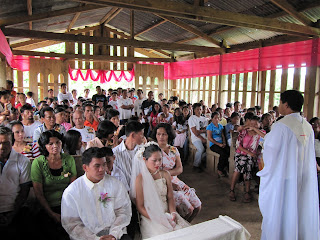 In Fr. Niall O’Brien’s best-seller prison diary, Revolution from the Heart, this Columban missionary unfolds the story of his twenty-year mission in the island of
Negros. Central to this story is the
struggle of the “Basic Christian communities” for liberation from poverty and
oppression in the times of Marcos dictatorship.
I remember reading the portion when Fr. O’brien went for his sabbatical
and found himself in the gigantic and elaborate Church edifices of Europe. There
he couldn’t help but notice the paradox: Huge and intricately ornamented
churches but very few people to worship God.
Back in Negros, the barrio chapels were just a little better than
crudely built shacks, but they were packed with the communities of the poor
worshipping the Lord and drawing from one another the hope they so badly needed
in the midst of oppression.
In Fr. Niall O’Brien’s best-seller prison diary, Revolution from the Heart, this Columban missionary unfolds the story of his twenty-year mission in the island of
Negros. Central to this story is the
struggle of the “Basic Christian communities” for liberation from poverty and
oppression in the times of Marcos dictatorship.
I remember reading the portion when Fr. O’brien went for his sabbatical
and found himself in the gigantic and elaborate Church edifices of Europe. There
he couldn’t help but notice the paradox: Huge and intricately ornamented
churches but very few people to worship God.
Back in Negros, the barrio chapels were just a little better than
crudely built shacks, but they were packed with the communities of the poor
worshipping the Lord and drawing from one another the hope they so badly needed
in the midst of oppression.
True worship springs from a community of people inspired by
the Spirit of the Risen Lord. Worship is
not tied to physical location like a well-ornamented temple. There can be no authentic worship in an empty
shrine. We can claim this truth now because Jesus has revealed it to his
followers through the mystery of his death and resurrection.
The gospel reading of today (Jn 2:13-25), Jesus’ cleansing
of the temple of Jerusalem, lends itself to a better understanding of the real
temple where God can truly be worshipped. After driving out with a whip the
sheep and oxen being sold inside the temple area, after overturning the tables
of the money-changers telling them to stop making his Father’s house a
marketplace, Jesus was confronted by the Jews with a demand for a sign: “What
sign can you show us for doing this?” To which Jesus answered: “Destroy this
temple and in three days I will raise it up.”
The Jews of course could not understand. Jesus was no longer speaking on the natural
plane. His reference to the temple was no longer the material edifice. It was naturally impossible to rebuild in
three days a massive temple constructed for about forty-six years. Jesus was speaking on the spiritual
plane. The temple which was to be destroyed
and later be raised up was his body.
The gospel of John uses this incident as one of the signs. This is the sign of substitution. Jesus replaces the material temple where God,
as the Jews used to believe, dwells and is exclusively worshipped. Through the death and resurrection of Jesus,
the temple is superseded by the new reality of a “Spirit-filled” Christ. Jesus Christ is the new temple. By his
resurrection he becomes the locus of the presence of God. And this truth
revolutionizes the way we experience and worship God. We encounter and worship God whenever and
wherever we gather and pray in the name of the risen Lord as a people. Our relationship with God is no longer dependent
on a particular location. God is not
confined to the temple or cathedral. God dwells in us. St. Paul says: “Do you not know that you are
the temple of God, and that the Spirit of God dwells in you?” (1 Cor 3:16).
Some implications:
In our pastoral concerns, according to PCP II’s vision, the building up of the communities of
disciples or the basic ecclesial communities should then take precedence over our concern for church edifice and its
beautification. The two, of course, do not necessarily contradict. It gives a lot of joy and comfort to the worshiping
community when our church buildings are spacious, clean and beautiful. But, again, they are only beautiful in as
much as there is a community that brings life to authentic worship. Let us not allow our priorities (time,
resources and energy) to be skewed on favour of inanimate edifice to the
detriment of our task in community building. Several times I celebrated the
Eucharist in the simple chapels of the barrios and they are the best experiences
of worship I ever had. It’s not because
of the location or building but because of the Spirit of the Lord who is alive
in the community.
Our worship does not end in the church where we celebrate
the liturgy. We are the temples of God. Our life and all that we do outside the church
must also be an expression of our worship.
We see then a continuity of our liturgical celebrations in the church
with our day-to-day life. We worship God
in and outside the church, by way of piety and by way of charity and commitment
to social justice. Our participation in the Alay-Kapwa Lenten campaign is part and parcel of our meaningful worship.
In this season of Lent, therefore, we are invited to
encounter and worship God, first, in our meaningful liturgical celebrations
that usher us, as a community, into a deeper relationship with God, second, in
our commitments to social charity reaching out to the poor and needy members of
the community, and third, in our personal sanctification as the temple of God
by way of repentance, striving to become worthy of God’s presence in our hearts.

No comments:
Post a Comment